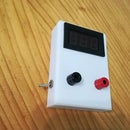Introduction: Adjustable Power Supply
This instructable is about how to make power supply with adjustable output and can be powered with various supplys .All you need is knowledge in electronics.
If you have any questions or problems you can contact me on my mail:iwx.production@gmail.com So let's begin
Components provided by DFRobot
Step 1: Materials
Nearly all needed materials for this project can be bought on online store: DFRobot
For this project we will need:
-wires
-surface mounted plastic sealed electric junction box case
-3.7V Li-ion battery
-various connectors
-SPST switch 4x
-red and black 4mm terminal binding
Step 2: Modules
For this project I used three different modules.
Solar power manager
This modul is very useful because it can be powered with different supplys. So it can be used in many projects.
It can be powered with 7-30V solar panel, 3.7 Li-ion battery or with USB cable.
It has four different outputs. From 3.3V to 12V, with 5V USB output and on one output you can choose voltage 9V or 12V.
Specifications:
- Solar input voltage: 7V~30V Battery input
- Battery input: 3.7V single cell Li-polymer/Li-ion battery
- Regulated power supply:
- OUT1=5V 1.5A;
- OUT2=3.3V 1A;
- OUT3=9V/12V 0.5A
DC-DC boost converter
Also very useful modul if you want to quickly make variable power supply. Voltage is regulated with 2Mohm trimmer.
Specifications:
- Input voltage:3.7-34V
- Output voltage:3.7-34V
- Max input current:3AMax
- Power:15W
Solar Lipo Charger
Designed for charging, with input reverse polarity protection. It has 2 LEDs for charging indication.
Specifications:
- Input Voltage: 4.4 ~ 6V
- Charging Current: 500mA Max
- Charging Cutoff Voltage: 4.2V
- Requisite battery: 3.7V lithium battery
If you want to know more about this modules you can visit: DFRobot Product Wiki
Step 3: Power Supply Housing
For housing I used surface mounted plastic sealed electric junction box case.
First I mesaured every component so that I knew all dimensions. The I stared to draw on the junction box so that I saw how everything will look. When I was pleased with designed I started to make holes for components.
I used 2 LED voltage meters for voltage display. One is displaying adjustable output and other one is displaying 9V/12V output, so that you know which voltage did you choose. This LED voltage meters are very useful because you just connect them to the voltage source and thats it. Only bad feature is that it doesnt show voltage under 2.8V.
I used 4mm terminal binding so that you are able to connect load to power supply. This power supply has 3 voltage outputs(9V/12V, 5V and adjustable output).
I also added two USB outputs so that you can directly connect your Arduino or some other applaince. It can be also used for telephone charging. Last output is used for battery charging (Li-po, Li-ion up to 4V.). For that I used solar battery charger.
Step 4: Supplys
This power supply can be supplyed with various power sources.
1.DC jack male
It can be powered with DC jack cabel. This supply is recommendable if you want to power sources that need a bit more power. This supplying also provides the most stability to outputs, that means that when you connect electrical consumer to output, the output voltage doesnt drop much.
2. 3.7V battery
You can use 3.7V single cell Li-polymer or Li-ion battery. In my case I used 3.8V Li-ion battery from my old cellphone. It can be fully supplyed just with this battery, but then it has some limitations to output voltage and current.
Regulated power supply efficiency (3.7V battery IN)
- OUT1: 86%@50%Load
- OUT2: 92%@50%Load
- OUT3 (9V OUT): 89%@50%Load
This possibility is very good when you are working somewhere where you dont have electricity.
3. Solar panel
For third option I choose solar power supply. It can be powered with 7V-30V solar panel.
In my case I used 9V solar panel which produces 220mA. At first look it seemed that it would be able to power this power supply. But when I stared testing this project with solar panel very thing shuted down because solar panel wasnt able to provide enought power to supply everything. When fully illuminated it produces around 10V and about 2.2W.
So then I stared to compensate it with other supplys. I combined 3.7V battery and solar panel. While testing it showed that battery and solar panel together are able to power this power supply.
So for supply this you will need solar panel that is able to produce more power.
For exemple:
Solar charge efficiency (18V SOLAR IN):78%@1A
If you supply it with 18V solar panel, its charging current will be around 780mA.
Step 5: Modifying Modules
For this project I had to make a little modifies to the modules. All modifications were made to make this power supply easier to use.
First I modified solar power manager module. I removed original smd switch and replaced it with 3pin single pole double throw switch. This makes switching between 9V and 12V more simple and it is also better because you can mount switch onto the housing. This modification can be also viewed on the picture. Power manager modul has option to switch ON/OFF outputs. I connected this pins to SPST switches so that you can manage outputs
Second modification was made on battery charger. I removed original smd LEDs and replaced them with normal red and green LED.
Step 6: Testing
When I wired everything together I had to make a test if everything works as I planed.
For testing output voltage I used Vellemans multimeter.
I measured 5V output. First when power manager was supplied only with 3.7V battery and then when it was powered with 10V adapter. Output voltage was same in both cases, mostly because output wasnt loaded.
Then I measured 12V and 9V output. I compared voltage value on Velleman multimeter and LED voltage meter. The difference between multimeter value and LED voltage meter value at 9V was about 0.03V and at 12V it was about 0.1V. So we can say that this LED voltage meter is considerably accurate.
Adjustable output can be used to power LEDs, DC fans or something like that. I tested it with 3.5W water pump.











